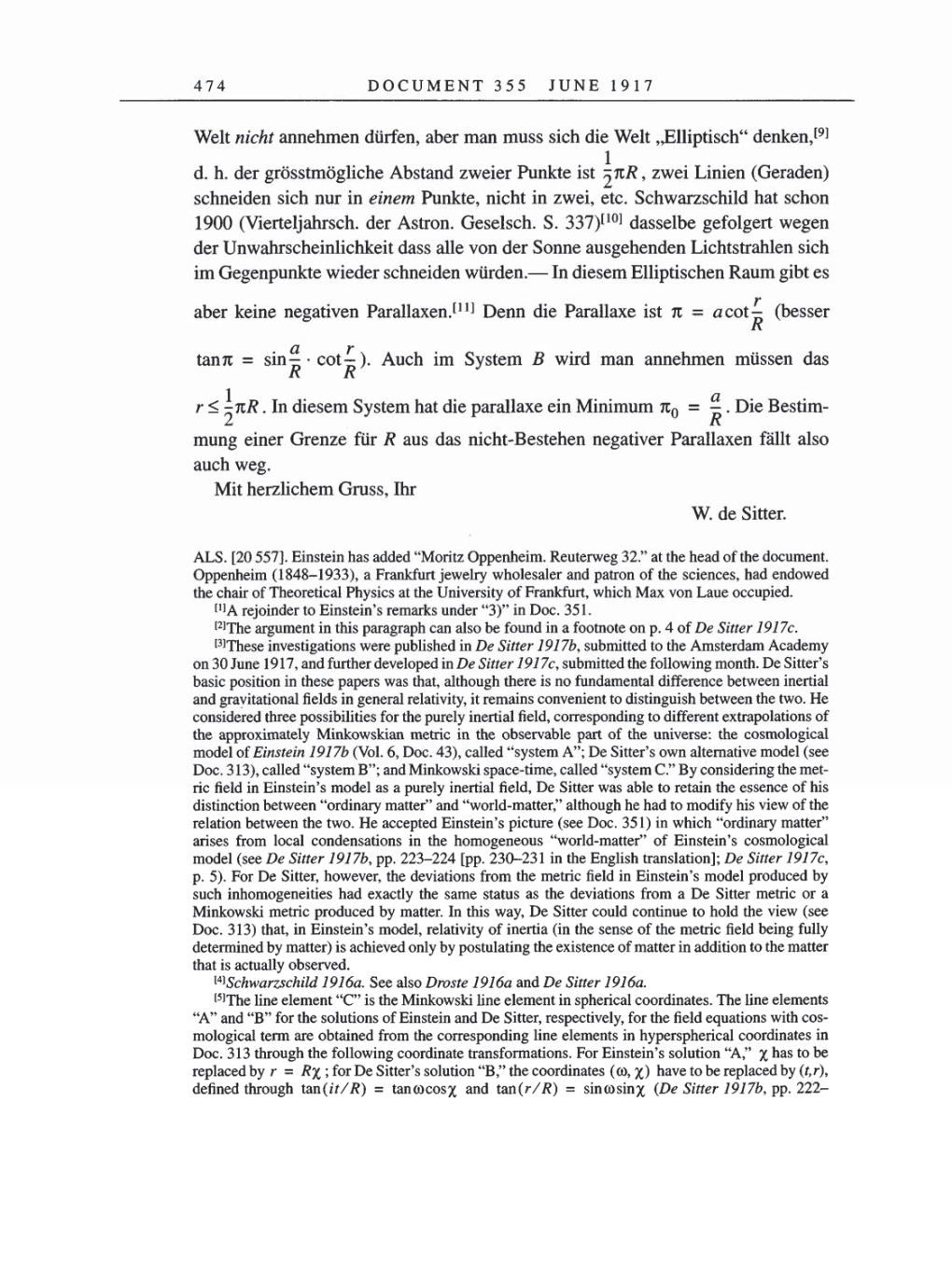474 DOCUMENT
355
JUNE 1917
Welt nicht annehmen
dürfen,
aber
man muss
sich die Welt
"Elliptisch“
denken,[9]
1
d.
h.
der
grösstmögliche
Abstand
zweier
Punkte ist
-jtiR,
zwei Linien
(Geraden)
schneiden sich
nur
in einem
Punkte,
nicht
in
zwei,
etc. Schwarzschild hat schon
1900
(Vierteljahrsch.
der Astron. Geselsch.
S.
337)[10]
dasselbe
gefolgert wegen
der Unwahrscheinlichkeit dass alle
von
der Sonne
ausgehenden
Lichtstrahlen
sich
im
Gegenpunkte
wieder
schneiden
würden.- In diesem
Elliptischen
Raum
gibt
es
aber keine
negativen
Parallaxen.[11]
Denn die Parallaxe ist
n
= a
cot-
(besser
R
d y
tarnt
=
sin-
-
cot-).
Auch im
System
B wird
man
annehmen
müssen das
R R
r
l¡nR.
In
diesem
System
hat die
parallaxe
ein
Minimum
7t0
=
Die Bestim-
2
R^.
mung
einer Grenze für R
aus
das
nicht-Bestehen
negativer
Parallaxen fällt also
auch
weg.
Mit
herzlichem
Grass,
Ihr
W.
de Sitter.
ALS.
[20
557].
Einstein
has added “Moritz
Oppenheim. Reuterweg
32.” at the
head of
the document.
Oppenheim
(1848-1933),
a
Frankfurt
jewehy
wholesaler
and
patron
of
the
sciences,
had endowed
the
chair of
Theoretical
Physics
at
the
University
of
Frankfurt,
which Max
von
Laue
occupied.
[1]A rejoinder
to
Einstein’s remarks
under
“3)”
in Doc. 351.
[2]The argument
in this
paragraph can
also be
found
in
a
footnote
on p.
4 of
De
Sitter
1917c.
[3]These investigations
were published
in De
Sitter
1917b,
submitted to the Amsterdam
Academy
on
30 June
1917,
and further
developed
in
De Sitter 1917c,
submitted the
following
month. De Sitter’s
basic
position
in these
papers
was
that, although
there
is
no
fundamental
difference
between
inertial
and
gravitational
fields in
general relativity,
it
remains
convenient to
distinguish
between the two. He
considered three
possibilities
for
the
purely
inertial
field, corresponding
to different
extrapolations
of
the
approximately
Minkowskian metric in the observable part
of
the universe: the
cosmological
model
of
Einstein 1917b
(Vol. 6,
Doc.
43),
called
“system A”;
De Sitter’s
own
alternative
model
(see
Doc.
313),
called
“system B”;
and Minkowski
space-time,
called
“system
C.”
By considering
the met-
ric field in Einstein’s model
as a purely
inertial
field,
De Sitter
was
able to
retain
the
essence
of
his
distinction between
“ordinary
matter” and
“world-matter,”
although
he had
to
modify
his view
of
the
relation between the two. He
accepted
Einstein’s
picture
(see
Doc.
351)
in which
“ordinary
matter”
arises from local condensations in the
homogeneous
“world-matter”
of
Einstein’s
cosmological
model
(see
De
Sitter
1917b,
pp.
223-224
[pp.
230-231
in the
English
translation];
De Sitter
1917c,
p. 5).
For De
Sitter, however,
the deviations
from
the metric field in Einstein’s model
produced by
such
inhomogeneities
had
exactly
the
same
status
as
the deviations
from
a
De Sitter metric
or a
Minkowski metric
produced
by
matter. In this
way,
De
Sitter could continue
to
hold the view
(see
Doc.
313)
that,
in Einstein’s
model,
relativity
of inertia
(in
the
sense
of
the metric field
being fully
determined
by matter)
is achieved
only by
postulating
the existence
of
matter in addition to the matter
that is
actually
observed.
[4]Schwarzschild
1916a. See also
Droste 1916a
and De
Sitter
1916a.
[5]The
line
element
“C” is the Minkowski line
element in
spherical
coordinates. The line elements
“A” and “B”
for the solutions
of
Einstein
and De Sitter,
respectively,
for
the field
equations
with
cos-
mological
term
are
obtained
from the
corresponding
line elements in
hyperspherical
coordinates in
Doc. 313
through
the
following
coordinate transformations. For Einstein’s
solution
“A,”
X
has
to
be
replaced by r =
RX;
for
De Sitter’s solution
“B,”
the coordinates
(w,
X)
have
to
be
replaced by (t,r),
defined
through
tan(it/R)
=
tan0)cosx
and
tan(r/R)
=
sincosinx
(De
Sitter
1917b,
pp.
222–
